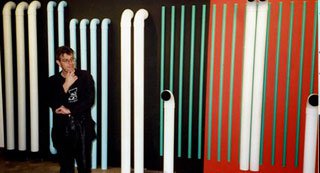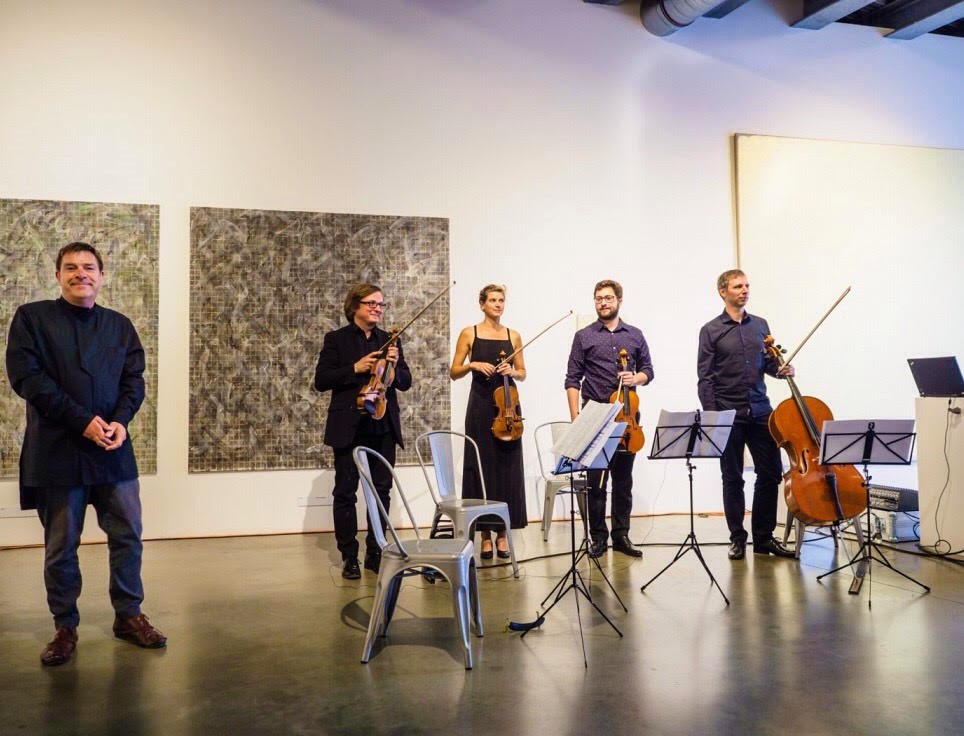
Recent projects Roland Emile Kuit
Sonologist- composer Roland Emile Kuit balances on the interface between
research, music and sound art. The new listening.
Roland Kuit has
been exploring and broadening the language of sound for over 25 years. In search
of new forms of listening Kuit started to create synthetic environments of
sounds in the '90's. Resulting in sound exhibitions in art galleries followed by
publications in art magazines as
l'Orbe and
Avenue Magazine,
Sound On Sound Magazine and WIRED.
To free these sound concepts from the traditional speaker boxes Kuit began the
transition of his sounds into installations. Visualizing sound. F.i. The
Electroacoustic Domestic Pet and
his cityscape
Paris, a Centre
Pompidou rebuild tubed speaker wall.

Roland Kuit started
studying the flute and piano at the
Royal Conservatory The Hague but
very quick switched to study electronic music at the
Institute of Sonology in
the 80's. With teachers/inspirators as
Gottfried Michael Koenig,
Werner Kaegi,
Stan
Tempelaars and
Jaap
Vink. Among
analogue studio techniques,
Roland learned to develop programs for
algorithmic composition and
digital sound synthesis.
The electronic possibilities in music and sound are infinite and were the right
tools for Kuit. Analogue and digital modular synthesizers and the
KYMA
system, a super
computer for sound, are the instruments for Kuit. Sound is typically a 'time
thing'. With this system, Kuit can influence the present by events that will
happen in the future. And vice versa. This is called Time Warping. And where an
acoustic instrumentalist can create twenty articulations per second, the Kyma
can do a thousand. Real-time analysis of sound of acoustical instruments or
other sounds can be done perfectly with the computer algorithms, creating
composition possibilities that are very interesting in the spectral realm.
In his early years
Roland made the connection between the other disciplines as painting, ballet,
sculpture and architecture. In
the 1996 Roland Kuit composed 'The
Rajlich Concept'
for the painter
Tomas Rajlich.
A work for violin, viola, double bass and synthesizer. Archives
Center Pompidou.
On 23-06-2017, a special world premiere took place in the
Kampa Museum
- The Jan and Meda Mládek Foundation in Prague (CZ).
This in honor of the exhibition
Tomas Rajlich: Zcela abstraktní retrospektiva.
An overview of the work of Tomas Rajlich. For this occasion Roland Kuit composed
a KYMA extended string quartet. With this three part work “Tactile
utterance”,
Roland succeeded in expressing the 50 years of painting by Tomas Rajlich. The new
ways in composition and research of physical modeling in spectral music Roland
had experienced at the
IRCAM in
Paris and the computer algorithms came together in this work.

Part 1: BRUSH,
from a pianissimo-bowed wood sounds to noise, to an elaborated crescendo of 8
minutes ending in a broad fortissimo textural cluster. The KYMA system producing
spectral echoes of the strings sounds.
Part 2: MAZE,
when we look at a grid, we see first concentrated - to open - to condensed
again. This goes for both horizontal and vertical. The string quartet
interpreted the 'intersections' by means of percussive violin sounds.
These sounds as a type of particles copied 100 times with the KYMA system,
resulting in a noise wall. A riterando to the center of the piece made that
these particles could be distinguished as single sounds. Of these single sounds,
Roland made "spectral pictures" that could be smeared as suggestions to
complement the grid lines. Followed by an acceleration to prestissimo particles
again.
Part 3: SURFACE,
multiphonics morphing to airy flageolets. The KYMA system creates algorithmic
multiplexed sounds and dissolving into a muffled softness.
The audience was captivated for 24 minutes by the music produced by the famaQ string quartet and Roland Kuit.
To
celebrate the
centennial of
the founding of the art movement
De
Stijl (2017),
Kuit created a triptych for Dutch radio station
Concertzender.
Roland Kuit is a creative expert in De Stijl movement and electronic music.
We
have a responsibility so see this with contemporary eyes and ears. To be radical
as well with respect to the past. Kuit’s research started in the
Mondrian house,
House of Birth of the painter
Piet
Mondrian:
Monads and Beyond. Together
with the Dutch Light artist
Karin Schomaker,
researching Mondrian and movement in digital visual arts (2013).
All started with the special relationship between
Piet
Mondrian and
composer - pianist
Jacob van Domselaer.
Between 1913 and 1917 van Domselaer composed
Proeven van Sijlkunst (Samples
of Style in Art, for piano, 1916). The first combined relation between the
horizontality and the verticality in music. Relating to the passivity and
activity. A static balance. The tension lies into the metre, the perpendicular
element. Supplemented by quasi-chaotic tone clusters.
Between 1950 and 1955, the Belgian composer and founder of the musical serialism
Karel Goeyvaerts,
managed to broaden this principle of the standing sound structures. Goeyvaerts
stacked electronic created sinus tones on each other as sound objects. Additive
synthesis.
CAHIER-M published
by the Dutch composer
Dick
Raaijmakers (2000)
is about the morphology of electric sound. This inherently single-layered type
of sound is discussed in the light of 'neo-plastic'
music as suggested by the painter Piet Mondriaan in the 1920's. He advocated a
kind of music that consisted of single-layered, 'single-colour' electric
sounds.
Roland Emile Kuit invented
sound and elaborates upon this. He engages in research as a ‘sound architect’.
Kuit constructed between 2010 and 2017 virtual electronic systems where
spectral chaos was
converted to
serial sound constellations.
Sounds that are captured at the atomic level and reduced to algorithmic
trajectories. He used pure tones to create spectral building blocks. This means
stacking energies to build harmonic sound planes. The diagonal aspect is
obtained by phase differences. The spatial modus is setting this weighed points
conscientiously in space to divide this spectrum and display it on a speaker
maze.
On
9 July 2017 the World Premiere of
Rietveld Pavilion
took place in the
sculpture park of the Kröller-Möller
Museum in
Otterlo. The Netherlands.
With this work Kuit makes a connection between, De STIJL constituted ideas,
architecture, and today’s art.
Kuit’s output spans composition through sound art, sound-architectural
installations, collaboration with experimental artists, designers and
scientists, acousmatic performance and live electroacoustic improvisation.
Research,
imagination and technical association made him write his books about combined
synthesis techniques. Lecturing at diverse universities and creating radio
programs about electronic music giving him a platform to discuss his conceptual
worlds.
Roland Kuit performs on
concert stages, art galleries and museums.
His books about
research in modular synthesis techniques, music and sound art are published by
Donemus, Publishing House of Dutch Contemporary Classical Music.